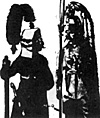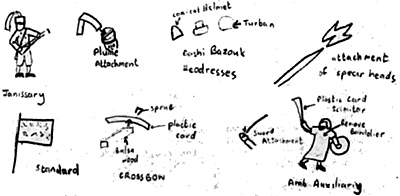 During the sixteenth century, the Turks amassed
a huge empire in the near east. At the height of its
power it stretched from Vienna to the Persian Gulf; from
the Crimea to the Caucasus to Algeria.
During the sixteenth century, the Turks amassed
a huge empire in the near east. At the height of its
power it stretched from Vienna to the Persian Gulf; from
the Crimea to the Caucasus to Algeria.
The army that took this empire was basically a feudal one; each landowner had to supply troops to the army according to what he owned. The best soldiers were the Janissaries and Spahis, the Sultan's Household troops.
In battle, the infantry consisted of three main types - the Janisseries, the bashi-bazouks, who were untrained irregulars who fought for plunder and the regular militia who formed a large part of the army.
Modelling the Janissaries is not as difficult as it seems at first. The Airfix Foreign Legion have neck cloths, baggy trousers and a long cost. Their large size also makes them fit in well with Warrior or Minifig Turks. The standard weapons of the Jaiiiesery are the musket and sabre, but they could be armed with bows, slings, crossbows, javelins, lances, straight swords, pikes, axes, scythes, maces or whips. These weapons were also the standard arms of the bashi-bazouk, who rarely carried the musket.
To make a Janissery musketeer, take any Foreign Legionary, cut away the pack, cap peak, bayonet and rifle slings and cut down the rifle slightly so that it resembles a musket. The water bottle and pouch are left on because they can be used as the powder flask and cartridge pouch; but if you think that this is too crudev cut them off and replace them. Add a sabre in its sheath from paper, card or plastic card.
 Now cut a slit in his cap from side to side about 2mm deep with a modelling knife.
Make the plume from paper, about 2mm x 13mm, put glue on the end and slide it into this
slot. Bend it back behind him about 4mm above his head. To make a differently armed
Janissery cut away all the equipment and rifle and make the new weapons as for the bashi-
bazouk (see below). Add plume and sabre as before. There is a picture of two Janissaries on
page 117 of Volume I of Funcken's "Arms and Uniform". From this I gained some idea of how
to paint them. Mine have light blue costs and trousers, red plumes and stockings, brown
pouches and a green sabre sheath with gold trimmings, a gold sash, white hat and gold
trimming on the plume.
Now cut a slit in his cap from side to side about 2mm deep with a modelling knife.
Make the plume from paper, about 2mm x 13mm, put glue on the end and slide it into this
slot. Bend it back behind him about 4mm above his head. To make a differently armed
Janissery cut away all the equipment and rifle and make the new weapons as for the bashi-
bazouk (see below). Add plume and sabre as before. There is a picture of two Janissaries on
page 117 of Volume I of Funcken's "Arms and Uniform". From this I gained some idea of how
to paint them. Mine have light blue costs and trousers, red plumes and stockings, brown
pouches and a green sabre sheath with gold trimmings, a gold sash, white hat and gold
trimming on the plume.
Bashi-bazouks used to equip themselves and so their dress and equipment varied. They can be made as the Janissaries but their headress is different. Mine have three different types of headress - a turban; a conical helmet and one as in the picture. All are made from plesticene, hardened by nail varnish. The turbans are just blobs of plasticene with black or grey lines painted on to depict strips of cloth.
Here is how to make their weapons - javelins, lances, pikes - fuse wire, pine or stretched sprue. Flatten the heads on pine with ahammer, file points on fuse wire and sprue. (Flatten heads on fuse wire as well). Swords - plastic card. Cut a slit in the hand and attach them like the Janissaries' plume. Axe - pine with plastic card blades. Mace pines with plasticene heads. Crossbows - balsa wood with a plastic bow (see drawing above). Whips = pins and stretched sprue. Shields can be square wicker, 10mm x 15mm, or a round metal shield about 10mm diameter. All are made from plastic card. Special barbed heads for spears are made by cutting a small ,v" in a plastic card blade and gluing this to the pin (see drawing).
These ferocious soldiers can be painted in browns and greys to represent natural wool, or in bright colours. Uniformity in dress is the last thing to expect.
The militia are dressed and armed as the bashi-bazouks, but appearance is usually far more uniform. Each unit usually had an emblem.
Arab auxiliaries can be made from the Airfix running Arab rifleman, with the rifle replaced by a scimitar and a shield on the other arm.
There are many other possible conversions to do, all colourful but perhaps I will write about these some other time.
Back to Table of Contents -- Wargamer's Newsletter #143
To Wargamer's Newsletter List of Issues
To MagWeb Master Magazine List
© Copyright 1974 by Donald Featherstone.
This article appears in MagWeb (Magazine Web) on the Internet World Wide Web.
Other military history articles and gaming articles are available at http://www.magweb.com